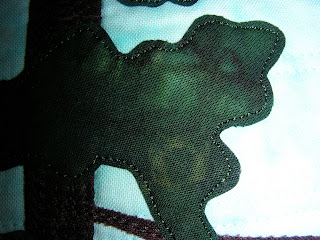I'm not a gadget gal.....of course I appreciate good tools but I def. don't try every new 'must have' product. And, I'm not especially a fan of raw edge appliqué. Bascially, I'm old school but there are times when raw edge appliqué makes sense.
This product certainly swayed my thinking and it's one you must have in your sewing room. My friend Linda Cantrell introduced me to Fray Block, made by June Tailor. (I purchased it online via JoAnne Fabrics).This is FAR superior to Fray Check and the other products most of us are already familiar with. It truly works, it's clear, DOES NOT stain your fabric or change its hand. Amazing!!
Linda suggested squirting some into a small container and applying with a tiny brush because it comes out of the tube way too quickly. The instructions call for placing the tube under hot running water for 3 mins. before using....Linda doesn't.
Though today was a bit chilly and I could see tiny particles in the liquid that normally aren't there. So I did as instructed, heating this product will assure it's clear when it's applied (and I assume also stain free!) Look how clean the fabric edge is after machine appliqueing.




10 comments:
Interesting. I never like how my edges look so frayed after finishing up a raw edge applique project. I am going to try this. Have you had any issues with it yellowing over time?
Mary here.....Carolyn asked if there was yellowing over time.......not in my experience. Linda Cantrell has been using this product for several years without any adverse results.
I've used Fray Check, but I'm always looking for something better. I'll have to get some on my next trip to Joanne's
Interesting product- Fray Check is sometimes a problem with its hard edge and odor.
Long ago, I used Fray Check on clothing seams. It was itchy. I have used Fray Block (I've been through a whole tube now) only in quilting. It's very good for turned-edge applique pieces...those sharp tips that are subject to fraying when worked, and inset Vs.
I use one of those flower-head pins as a cap (doesn't rust), and the pin can be an applicator, too!
not seen this before and never tried fray check either, mind you have not tried applique yet
So many things I want to try
I'm with you, Mary, when it comes to an old school preference for turned appliqué vs. raw edge. However, there are times when raw edge makes more sense than turned. Thank you for suggesting Fray Block. What I am now curious about is how did you secure the appliqué to the background while you stitched around it? Did the edge of the appliqué get trapped under the prong of your machine foot?
Mary answered Gwen question. The appliqué motifs were fused to the background....then treated with Fray Block, then using an open toe foot, straight stitched along the outer edges. Hope this clarifies the process I used.
Interesting. I must try this! I don't mind the raw edge, but some fabric just fray too much. Thanks for the tip!!
Well, goodness - it all seems so logical once you mention it but even though I've been using this product for a long time, it never occurred to me to use it this way. I can't even remember what I was using Fray Check on at the time I found out about this alternate product, but I do remember it was the promise of keeping the fabric edge soft that made me want to try it. I've used it along the edges of fabric postcards and padfolios before satin stitching them - it helps tame the little thread hairs that always pop out. Why I never made the leap to controlling thread hairs on raw edge applique is a mystery.
Applying with a brush - now that IS brilliant! Because indeed, using the tip of the tube, the liquid can get away from you. I generally do not have the patience to heat it under water, and the one time I did, it just shot out of the tube and was totally uncontrollable (but using a brush would have solved that). Really didn't understand the why of heating it up and at most I let it warm in my hands a bit and thoroughly shake. (Also ran into a tip to slip it in your waistband against your body to keep it warm). Now I know why I should warm it up. Thanks for this great tip.
Thanks to Rebecca too - some additional great tips. Again wondering why they never occurred to me...
Post a Comment